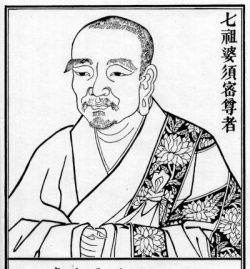Five Vasumitras
Jump to navigation
Jump to search
According to Fa-jen[1] there are, so far as the Chinese Buddhist literature is concerned, five Vasumitras:
- 1) The Vasumitra who appeared at the beginning of the third century after the nirvāna of the Buddha and who is the author of the Parakarana pāda and Dhātu kāya pāda sāstra.[2]
- 2) The Vasumitra in the fourth century after the Buddha. He was one of the four great Sthaviras at the time of the compilation of the Mahāvibhāsā in the reign of King Kaniska.[3]
- 3) The Vasumitra of the Sautrāntika school who taught a theory that even in the abstract meditation which is called extinetion (nirodhasamāpatti) there is a subtle mind.[4]
- 4) The Vasumitra who appeared a thousand years after the Buddha and whose name was given in the Abhidharmakosa sāstra.[5]
- 5) The Vasumitra from whom Hsuan-chuang learned the doctrine of the Sarvāstivāda school in Kashmir.[6]
Minayeff based on Tāranātha’s History of Indian Buddhism also enumerated five Vasumitras:[7]
- 1) The Vasumitra who lived at the time of Kaniska.
- 2) The Vasumitra who emigrated to a country neighbouring to Tokhara accompanied by Gosaka.
- 3) The famous scholar of the Vaibhāsika school.
- 4) The author of the Abhidharma sāstra prakarana.
- 5) The author of the commentary on the Abhidharmakosa and also of the work called Wheel showing the differences of the Eighteen Schools.
Footnotes
- ↑ Fa-jen I. P. 1b.
- ↑ T. E. T. 41, P.817b.
- ↑ T. E.T. 51, P.886c. 大唐西域記Cf. the Shuchi I; Fa-jen I, P.2b.
- ↑ T. E. T. 41, P.100b.
- ↑ T. E. T. 41, P.37b. This Vasumitra is uncertain, because the note says that in another commentary mentioning that it is Srirāta, the famous Sautrāntikāh master who was a contemporary of Vasubandhu.
- ↑ T. E. T. 50, P.231b. The Fa-jen has made a mistake, as the text mentioned that at that congregation in Kashmir there were many learned monks, and among them there was a Sarvāstivāda student called Vasumitra. But the venerable master, from whom Hsuan-chuang has learned the doctrine of the Sarvāstivāda School, was called Sanghayaso.
- ↑ Minayeff, Recherches Sur le Bouddhisme, (Annales du Musee Guimet, Tome IV). Paris 1894, P.196f.
